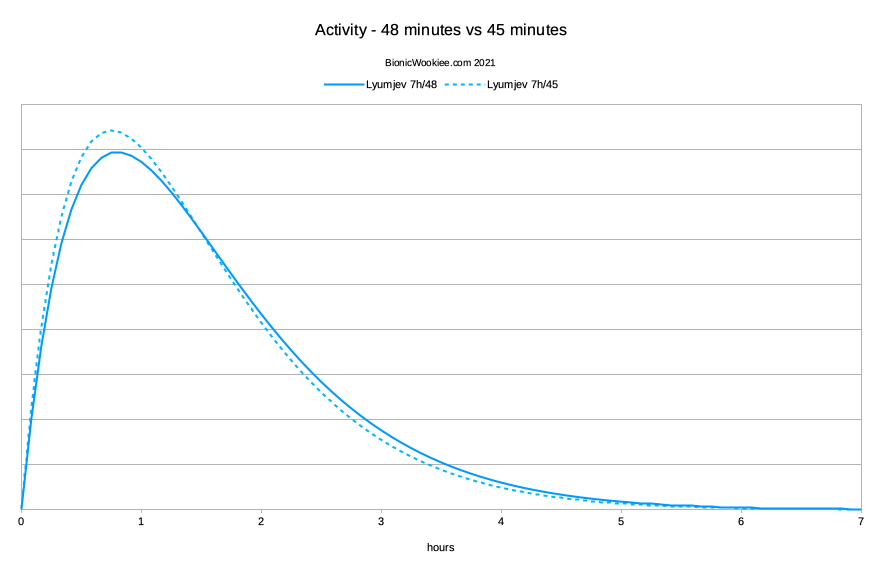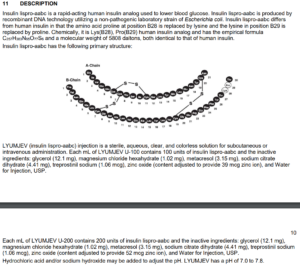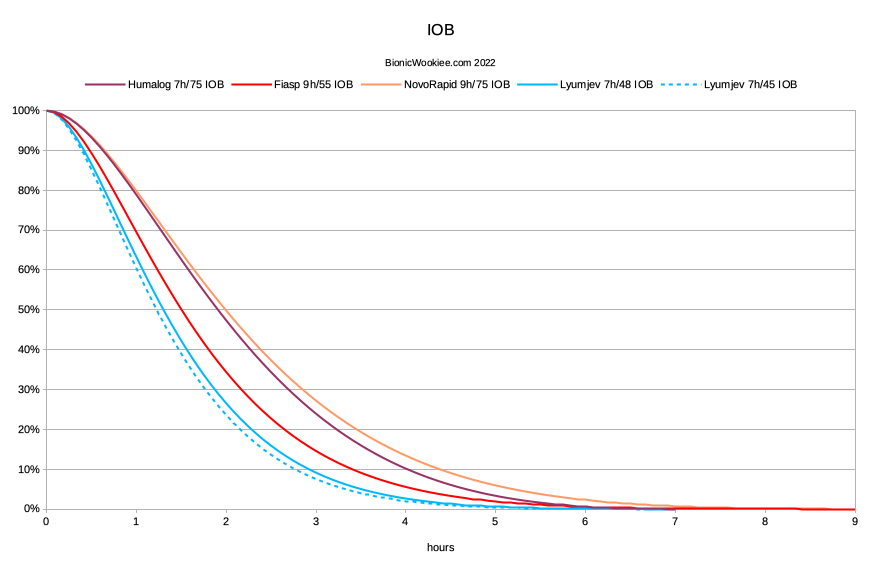Back in December I wrote about some of my experiences using ultra-rapid Lyumjev insulin in my closed-loop system, but there were a couple of unanswered questions. Particularly to do with “bolus stings” and with the speed/activity of Lyumjev.
I’ve now done some further work which has hopefully clarified those questions.
Just to re-iterate for the Australians in the audience: Lyumjev is not yet available in Australia. It’s not even approved by the TGA yet.
Lyumjev stinging
Lyumjev is well-known for causing stinging/irritation during boluses for many people. Particularly in its U100 form. The trepostinil vasodilator that gives some of the speed to Lyumjev is also known for this in other contexts. Anecdotally this fades over time (months) but some people have found Lyumjev so painful they’ve been unwilling to struggle through in the meantime.
As seen in this extract from the Lyumjev product information, the U200 form of Lyumjev has the same trepostinil concentration by volume as the U100 form (and thus half as much per unit of insulin). Many people have reported they don’t get the stinging with that, even when using it off-label in insulin pumps.
Mixing Lyumjev and Humalog
Humalog contains the same insulin lispro insulin molecules as Lyumjev, just without the added accelerants.
I definitely noticed stinging with straight Lyumjev in an initial experiment. It was very noticeable! So for months I have been using a 50:50 mix of Lyumjev and Humalog. The mix was done by half-filling each pump reservoir with Lyumjev then topping it up with Humalog. Due to the vagaries of dead-space in the reservoir and variations in manual measurements it was never exactly 50:50, but fairly close. Of course, it was always still U100 insulin.
Thus the trepostinil mixture was the same concentration per unit of insulin as U200 Lyumjev (although half as much per physical volume) and should be a reasonable compromise. The mixture still contained the normal amount of buffers/preservatives/etc so should be stable for the remaining life of the insulin.
Yes there can always be stinging
This mixture has worked well for me. I did notice some boluses at first, but no more stinging than I experience with other insulins. Occasionally I would have an infusion site which did sting, but that’s been an occasional thing over many decades with many different insulins.

Removing that infusion site and moving to a new body location has always fixed it. I’ve always put this down to issues with the cannula placement. Such as sometimes too close to a nerve (or a blood vessel) and the physical disturbance of the insulin administration “tickles” the nerve.
Note that when I say “occasionally”, I mean maybe once or twice a year. Years ago I had a period where it was much more common, but that went away after I started rotating my site locations in a better pattern to give each site more time to heal.
Also note that the stinging from acidic insulin glargine (Lantus/Optisulin/Toujeo) is a very different thing. All the insulins we use in pumps are pH-neutral and do not have that impact.
Observed action
So I had an insulin which didn’t sting, and worked a LOT faster than Humalog (or even Fiasp). Through observation in my loop system I ended up modelling the activity profile of the insulin as having a peak of 48 minutes and a total duration of 7 hours.
7 hours might sound long, but by 3 hours 90% of the insulin would be used up: after that there’s just a “long thin tail” of activity.
But 48 minutes is different to the 45 minutes that is classically used for Lyumjev. How much difference does that make in the insulin model we use with the oref algorithm? Not a huge difference, but still noticeable.
 Switching to 100% Lyumjev
Switching to 100% Lyumjev
After 3 months of using the Lyumjev/Humalog mixture, I decided to try 100% Lyumjev again.
Because of the issue with a bad site sometimes causing stinging, I changed insulin without changing site at the same time. This infusion site had been working great for a day, when I replaced the pump reservoir and re-primed the tubing before proceeding. So I knew if there was suddenly stinging then it would be the insulin and not a new site at fault. And what happened?
No stinging. I have now been using it for over a week, and it just feels like any other insulin. And it’s not just me:
Emboldened by my discovery, two other people I know who have also been using a Lyumjev/Humalog mix for months have also tried the experiment. And they report the same thing: no stinging (whereas their initial attempts to use straight Lyumjev had been quite painful).
So based on this small sample, I think it’s likely that we’ve gradually acclimatised our bodies to the trepostinil in some way.
Mind you, there can be a lot of variation in how someone’s system is set up. My loop administers insulin in a combination of temp basals (usually a tiny amount delivered every 3 minutes by the pump based on an hourly rate) and “micro-boluses”. I don’t give big boluses for meals, and let the system dose insulin for food/etc automatically in the background (usually triggered by 5-minute CGM updates).
It’s been years since the system gave me an individual bolus as large as 2U. It seems this can only help avoid issues with the sensations of larger boluses. Reducing the delivery speed of the pump may also help (I remember the Animas pump’s 60 U/min “normal” speed being quite noticeable in 2009, but the 12 U/min “slow” speed was much better).
Change in speed
Not surprisingly, I have found I’ve had to change the insulin activity profile in my loop system to use 45 minutes.
Because this means that the faster form will have used 104% as much insulin by two hours, I also had to increase the insulin sensitivity (ISF) declaration by 4%: from 2.6 to 2.7 mmol/L per U.
After making those two changes, my loop has been performing wonderfully. I haven’t noticed a dramatic difference compared to the slightly slower mixed insulin, but then I’ve managed to configure my fully-closed system so it works well with Fiasp and even works with Humalog and NovoRapid. The faster the insulin the better, and I definitely notice the jump from Fiasp to Lyumjev/Humalog. But the step up to straight Lyumjev has so far seemed more subtle.
Admittedly I may return soon to using the mixture. Purely to stretch out my remaining supply of Lyumjev before I have to either get another batch from overseas or return to using Fiasp!




Did you mean “But the step up to straight *Lyumjev* has so far seemed more subtle.”?
Have you tried mixing U200 Lyumjev with Fiasp instead of Humalog? Would be interesting to see whether that works even faster.
Good catch, thanks.
Mixing Fiasp and Lyumjev might be interesting, but Lyumjev and Humalog are the same fundamental insulin, and the accelerant should affect it all in the same way. Trying to accurately model the activity profile of the “7h” lispro combined with the “9h” aspart could be challenging.
Years ago I mixed Humalog and Fiasp, but in retrospect I’m sure I did not do a good job of modelling the mix at the time.
Of course mixing U200 and U100 does mean you need to be fairly accurate so you can calculate the effective concentration of the mixture. Using U100 Lyumjev would avoid that complication.
I have tried mixing 50/50 Fiasp and Lyumjev together in my pump. Both at U100 concentration.
I didn’t notice any difference compared to 100% Lyumjev U100 in terms of peak action time.
I was using Fiasp, as I had a leftover vial when I switched to Lyumjev and Lyumjev at 100% was stinging quite a lot initially.